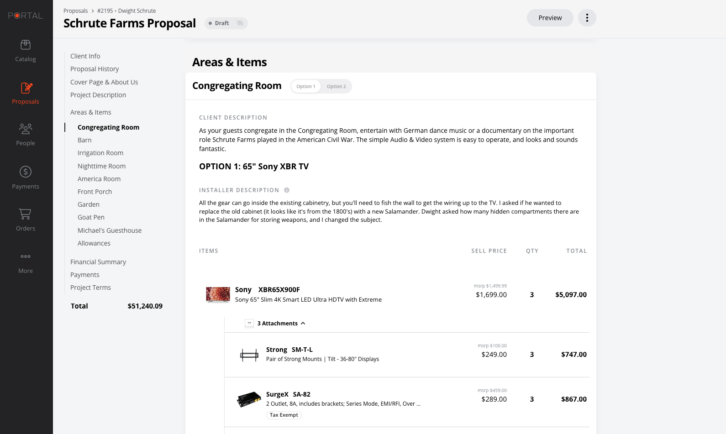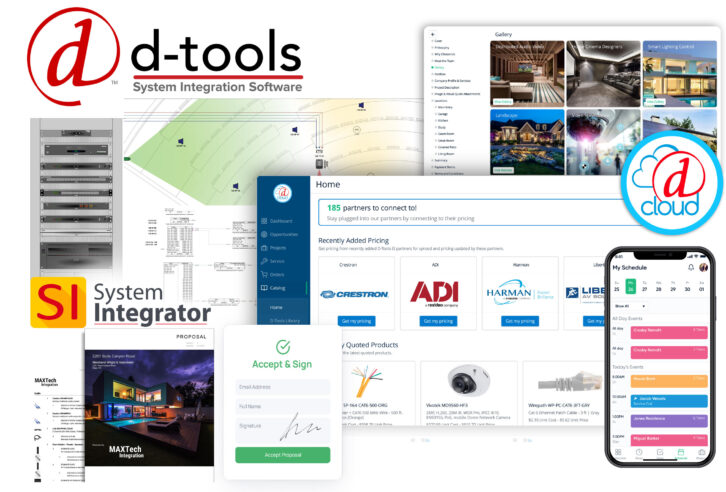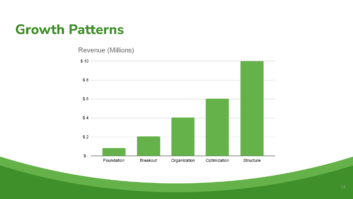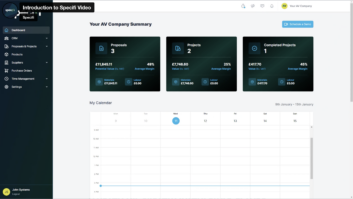The right business software can make managing a CI business much easier. CI-centric business services not only help in keeping track of cash flow, but also offer various platforms and modules that can enhance the company’s overall performance.
Jetbuilt, for example, began eight years ago as a quoting tool, populating items, analyzing costs and margins, then presenting a proposal to the client. At first, the company took pride in its single offering, to be known for fast and powerful proposals. “We did not have a desire to create a start-to-end workflow platform, but our customers had other plans for us,” says founder/CEO, Paul Dexter. “They strongly expressed the need to consolidate their many platforms. They wanted to roll in their sales CRM, project management, time tracking, inventory management, service ticket platforms, and more. We listened and invited them to design these modules with us. Over the last eight years we’ve grown into a lead-to-support platform where a CI can perform every aspect of their AV business, short of accounting, from the initial client lead, to supporting projects for the long-term.”

At D-Tools, software users cover a broad range of companies, including large and small residential integrators, commercial AV-focused integrators, security integrators, electricians, HVAC contractors, and more. “The software is even used by higher education institutions, corporate facilities, and government entities,” says Jason Knott, company data solutions architect and evangelist. “The highly intelligent software enables integrators to quickly create effective and profitable proposals using a comprehensive product library of more than one million dealer-priced products. Moreover, the software has expanded well beyond simply being a tool for system design, documentation, and proposal creation. Today, it is a full end-to-end software solution that acts as a CRM to track sales opportunities, offers visual quoting and system layouts, provides full project and service management, and integrates with platforms for engineering drawings, inventory, and accounting. Like any software solution, it is dynamic, with new updates every month.
Integration Guide to Projection Screens – Big Screens for Big Scenes
“Founded in 1998 by chairman Adam Stone, the company pioneered the category of data-driven proposal, system design and field service management with its on-premises System Integrator (SI) software. In 2019, D-Tools introduced its cloud-based platform, D-Tools Cloud, designed to help smaller companies and projects streamline sales processes. Today, D-Tools Cloud is now a complete end-to-end solution from initial client engagement through field service management. Combined, D-Tools SI and D-Tools Cloud have nearly 8000 companies using the software.”
Reducing Friction
Portal started as a web-based product catalog and purchase order tool for dealers back in 2013, notes president Josh Willits, an electrical engineer and former integrator. “Our goal was to solve a major problem facing the industry — the difficulty in accessing and maintaining product data. The product catalog remains the core of our business software. In 2014, we added our proposal functionality, which was made easy because it was built on the managed product catalog. The Proposal tool became the most popular part of Portal, and is where we put nearly all of our development focus over the last few years. Our goal is to reduce friction for dealers in their business by making software that is intuitive and fast.”

Historically, Portal has been known as a simple proposal tool that is fast and easy, but with a slightly limited feature set. “Although our client base has always included larger Integrators, Portal was admittedly better suited for small- and medium-sized dealers before they were ready for a full business software suite,” Willits explains. “However, over the years we had larger dealers who loved our speed and ease of use asking for more. Over the last three years we’ve focused on developing new features that these larger dealers were asking for, like auto-attaching labor and accessories to parts, payment management, and now change orders, which is in development. Additionally, we’ve built integrations with other software tools like iPoint, ProjX360, and D-Tools so that dealers who need solutions for other parts of their business workflow could continue to use Portal with these other software tools.”
Latest and Greatest
Portal recently showed off its new features at CEDIA Expo 2023. “Most significantly, released earlier this year was the most requested feature from dealers — Auto Attach labor and accessories to products, allowing integrators to create packages that can be added to a proposal with the click of a button,” says Willits. “This feature is built on proprietary intelligent item suggestion functionality using the dealer’s account activity as well as industry popularity to suggest the most relevant related items.”
Portal has also just rebuilt its integration with QuickBooks online, giving dealers more control over how proposals push from Portal into their QuickBooks accounts. “Our integration was already incredibly simple and easy to use, and this takes that to the next level by adding more flexibility,” he says. “We integrated QuickBooks Payment Processing into our Payment module. We also improved our Payments functionality, allowing dealers to now bring their own processor. This starts with QuickBooks Online payment processing and Stripe, and will continue with other third-party processors, allowing dealers to negotiate the best rates and payout times with their preferred processor, while leveraging Portal’s Payment functionality such as presenting the customer with auto-calculated payment options immediately upon accepting a proposal.
“Videos are a powerful way to communicate ideas and functionality, so we have an active YouTube channel where dealers can learn about Portal, see how it works, and follow our newest features and updates.”
Feedback from Portal’s CI dealers, tracked through its NPS (Net Promoter Score), has yielded positive comments from integrators who compliment the platform for its professional-looking proposals and well thought out and convenient software.
The latest offering from D-Tools is a new partnership with Modus VR that will enable integrators to include virtual reality walkthroughs in their D-Tools Cloud proposals. “The software offers 360-degree views to help customers envision the end results while helping installers plan,” says Knott. “Modus 360 landscapes can be output and embedded in D-Tools proposals, allowing both integrators and end users to access them.”
D-Tools recently announced SI v20, the 20th version of its on-premise System Integrator software. SI v20 supports integration with Microsoft’s Azure Active Directory for enhanced security and Single Sign-On functionality. “The new version of the platform includes improvements to Pricing and Labor, such as the ability to add multiple vendors and labor types to products,” he adds. “The new version also boosts capabilities of Purchasing and Field Service management, along with better performance of features including projects, tasks, checklists, workflow rules, and more.”

Tim Haas, Haas Design Company, says the D-Tools overall workflow is simply intuitive, especially for the low-voltage industry. “It’s almost a no-brainer not to use it. Creating proposals and drawings is a breeze, thanks to the extensive product catalog. Our proposals consistently outshine those of our competitors, and we receive continuous positive feedback.”
At Jetbuilt, the latest offering is what its calls “Accelerating Project Initiation.” “This is a fancy way of saying that we’ve just launched a batch of features that helps a CI to take a project from a verbal ‘yes’ to actual construction,” says Dexter. “This begins with our eSign functionality, which then triggers alerts to the CI that a project has been sold. It sends the contract to accounting, the resulting payment triggers notices to project managers, and purchasing to begin ordering and installation. It’s amazing how this process is still very disconnected at most firms, which results in delays and early frustrations by both the client and the CI, who share an equal desire to move the project forward without bumps in this still-fragile early relationship.”
Jetbuilt customer Charlie McCourt, co-founder/director of Equippd, says the project had a great initial spec, but Jetbuilt has helped to almost double the size of the contract as well as capture and pass on expenses through the software’s Factor and Change Order features. “Jetbuilt is one of the tools that help us deliver quality integrations consistently and on time.”
Education at CEDIA Expo 2023
“Coming off CEDIA 2023, we learned a few things about what CIs are wanting that they couldn’t find elsewhere,” Dexter says. “Regarding the Jetbuilt Mobile App, many people had no idea that such a comprehensive mobile app exists. Not only can it be used to populate, present, and sell a project, but it tracks installation tasks and clocks techs in and out, reporting time with payroll reports and P&L tracking of that time.
“And CIs are frustrated with how to create bundles, or assemblies, which can quickly be added to projects, ” he says. “They were surprised to see that in Jetbuilt they can build, edit, hide, expose, and much more all on the fly without ever leaving where you are in a project. Then you can add one of them to a project a year from now and they will appear with each item’s current pricing. And companies had no idea how many automations could be built with the API. The ideas are endless.







